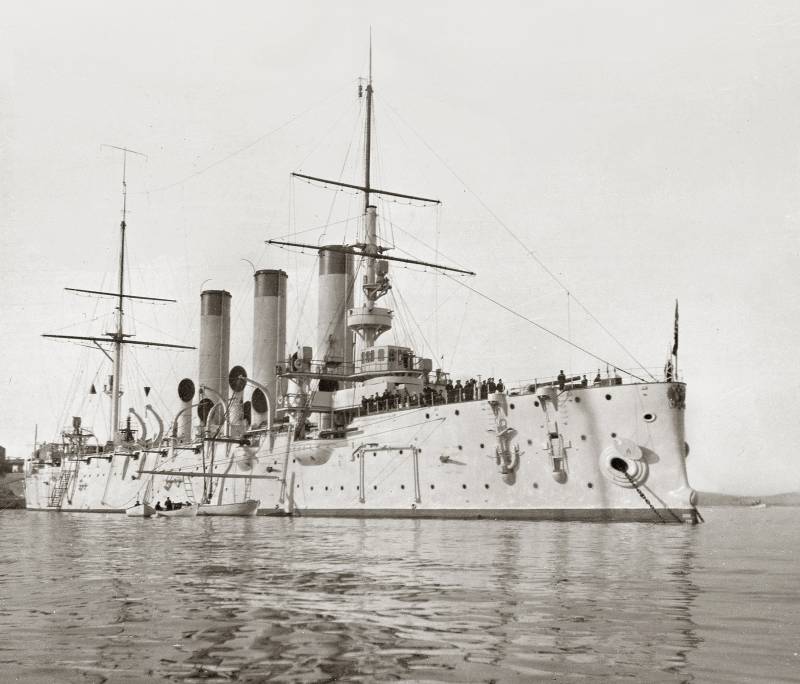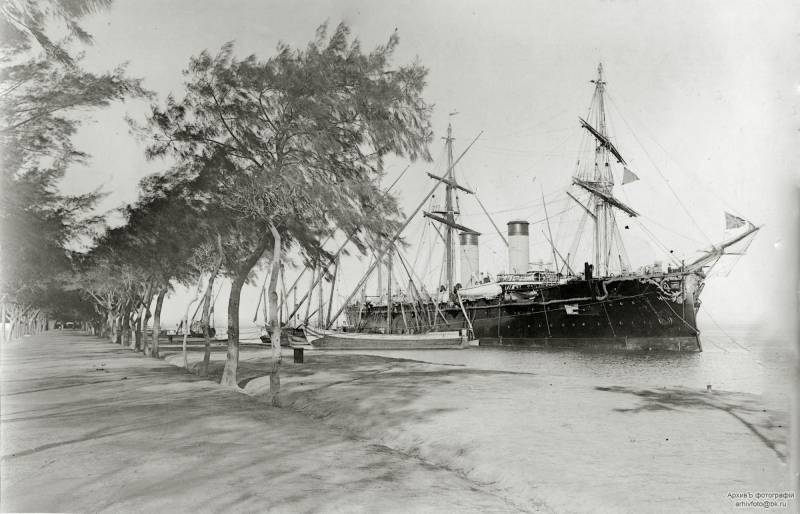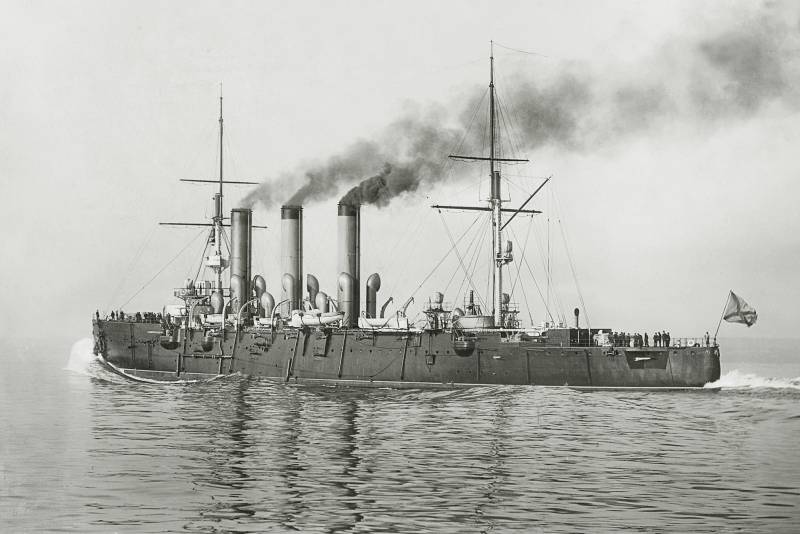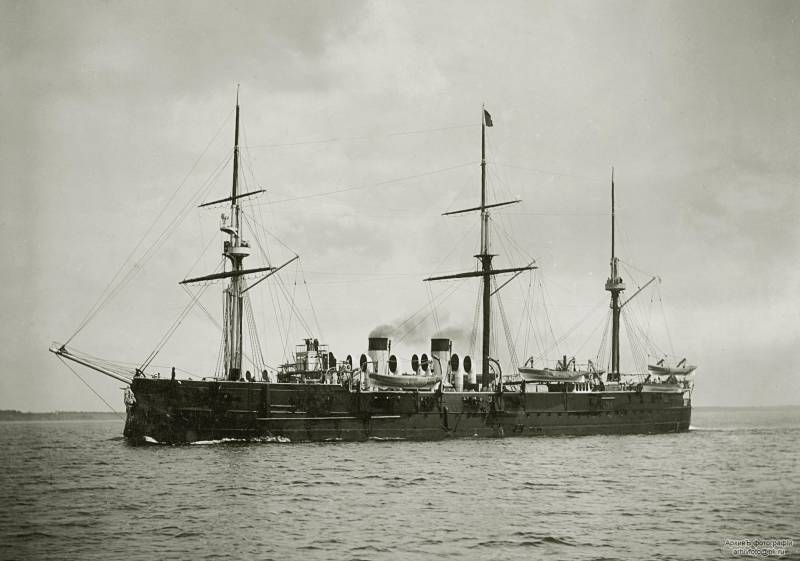Great losers. Diana-class cruisers
The Diana-class cruisers came out very beautiful. For many lovers stories naval fleet, their recognizable, neat three-pipe silhouette became the hallmark of the domestic military shipbuilding of the pre-tsushima era.
Unfortunately, this list of advantages of cruisers of this type can be considered exhausted.
Why did this happen?
Prerequisites to create
not the constitution,
not the stellate sturgeon with horseradish.
In the 80s of the nineteenth century, the shipbuilding programs of the Russian Empire in terms of cruisers were an extremely entertaining sight.
In 1881, two armored cruisers were laid down (more precisely, semi-armored frigates, but to avoid confusion I will call them armored cruisers) "Dmitry Donskoy" and "Vladimir Monomakh". Theoretically, they should have become the same type of ships of moderate displacement, designed for operations in the ocean. In practice, they turned out different types of ships with a moderate cruising range of 3 miles.
Nevertheless, the construction of such ships for the Russian fleet looked quite justified, because the main task of Russian cruisers in those years was considered to be fighting on British communications. For this purpose, an armored cruiser of moderate displacement at first glance was quite suitable: powerful enough to withstand any enemy that does not carry side armor, but at the same time it is still budgetary, which means that at the very least suitable for serial construction.
But in 1883, the Vityaz corvette was laid down, which did not have side armor, and with approximately the same cruising range - 3 miles. The ship had a significantly smaller size, 200 thousand tons versus 3,5 thousand for the Monomakh and, obviously, the price was much cheaper.
A year later, the laying of almost the strongest Admiral Nakhimov in the world followed: from the point of view of firepower, it could perhaps even be written down in battleships of the 2nd rank, but it did not differ in high cruising qualities.
Here, to an outside observer, it might seem that there is a reversal from the concept of a small armored raider for massacre on communications to large and powerful cruisers for squadron combat. In this case, the interruption of maritime trade in the ocean could be assigned to relatively cheap "second-rank" cruisers, which was hinted at by the construction of the Vityaz.
But after some two years, in 1886, the Monomakh and Donskoy line was continued - the Memory of Azov was laid with a normal displacement of about 6,7 thousand tons.
It would seem that the idea of small armored raiders still prevailed, but in the same 1886, the cruiser Admiral Kornilov was ordered in France, which, in terms of displacement (5,3 thousand tons), was only slightly inferior to the Memory of Azov, but at the same time was just armored.
The question arises - why should the fleet build ships of similar sizes, but of different subclasses (armored and armored) to perform the same task?
But still, watching from the side, it could be assumed that the Russian fleet finally decided to rely on cruisers of 5-7 thousand tons of displacement, intended for operations on communications.
However, the next Russian armored cruiser "Rurik" became the forerunner of a completely different concept.
It was a giant ship, whose displacement exceeded the Navarin and Sisoy Veliky squadron battleships laid down at about the same time, but which was completely unsuitable for either a squadron battle or large-scale construction. But the estimated cruising range of 6 miles, excellent seaworthiness and a speed of 700 knots were unparalleled in our fleet.
However, the advantages and disadvantages of the Russian cruisers-raiders Rurik, Rossiya and Gromoboy, which amaze the imagination, are an excellent topic for a separate series of articles, and I will not delve into it now.
The fact is that over the course of 10 years, from 1881 to 1890, the Russian Empire managed to lay down 5 armored cruisers of three different concepts and at the same time interrupt the creation of armored cruisers for quite a long time, since the next ship of this subclass was ordered for construction only 10 years after Kornilov.
And yes, to say...
The history of the Svetlana, laid down in 1895, is certainly interesting, but from the point of view of the evolution of the views of Admiral General, Grand Duke Alexei Alexandrovich on the characteristics of the yacht he desired.
By and large, the concepts of cruising war had nothing to do with it, although in fairness I’ll note that the Svetlana turned out to be not such a bad small cruiser.
Under such conditions, the Russian admirals came to the conclusion that our fleet still needs armored cruisers.
Design history
The performance characteristics of future cruisers were predetermined by the following three circumstances.
1. The construction of squadron battleships in the Baltic was gaining serious momentum. In 1889–1892 As many as five squadron battleships were laid down: "Navarin", "Sisoy the Great" and three ships of the "Poltava" type, while the Russian Empire was not at all going to stop there. Accordingly, a powerful armored squadron was formed, and cruisers were needed that could serve with it - perform reconnaissance and patrol functions, etc. Armored cruisers of the 2nd rank were very well suited for this.
2. Giant cruisers, like the Rurik, could not be built in numbers that would interrupt England's maritime trade. Accordingly, cheaper cruisers were needed, which, nevertheless, were distinguished by their great seaworthiness and cruising range. These requirements were fully met by armored cruisers of the 1st rank.
3. And, finally, the usual desire to save money: the maritime ministry really wanted the above tasks to be solved by one type of ship.
Accordingly, in 1894 a competition was announced among Russian shipbuilders. They were required to demonstrate the project of an armored cruiser with a displacement of no more than 8 tons, armed with 000 * 2-mm guns at the ends, 203 * 8-mm guns on board and a speed of at least 120 knots.
There were quite a few of them: with a displacement of 7,2–8 thousand tons, armament 2–3 * 203 mm and 8–9 * 120 mm, and the cruising range reached 9 miles.
But further work in this direction was stopped.
In my opinion, this was the right decision. Such ships would already be close in size and cost to the Japanese armored cruisers, having neither the weapons nor the protection of the latter, and their huge cruising range would be unclaimed.
Be that as it may, Vice-Admiral Chikhachev demanded a cruiser "with two closed decks, but artillery concentrated entirely on the upper deck", and by May 7, 1895, preliminary studies of cruiser projects were presented in 4,4; 4,7 and 5,6 thousand tons of normal displacement.
The speed of all cruisers was the same - 20 knots, but the cruising range grew along with the displacement - 3, 495 and 4 miles, respectively.
The armor was the same: the armored deck was 63,5 mm, the conning tower was 152 mm, the elevators and the lower parts of the chimneys were 38,1 mm, the glacis of the machine hatches were 127 mm.
But the composition of the weapons varied significantly: the “main caliber” of the smallest cruiser was represented by 2 * 152-mm and 8 * 120-mm, the average - 2 * 203-mm and 8 * 120-mm, and the largest - 2 * 203-mm mm, 4*152mm and 6*120mm.
In my opinion, reducing the displacement of future cruisers was completely justified. Both for service with a squadron and for raiding in the ocean, multiplicity is important, and large and, accordingly, expensive cruisers cannot be built in many.
The composition of the weapons raises questions.
On a cruiser of 4 tons, it would be more correct to leave a single main caliber of 400-mm or 120-mm guns. Placing 152-mm artillery on a cruiser of 203 tons is doubtful.
Simply put, the ship will not be a stable platform for such guns, which was quite well shown by the same Japanese Kasagi and Takasago. Each had a pair of 203-mm cannons, but during the entire war there was not a single confirmed hit from them (it is possible that they hit someone, but this is not certain).
Eight inches look justified only on the largest cruiser of 5 tons of displacement, but on it the designers managed to provide for two medium calibers at once - 600 and 120 mm, which is clearly unnecessary.
In my opinion, the terms of reference for a cruiser of 4,4-4,6 thousand tons with weapons from 7-8 152-mm guns and a speed of 20 knots would be optimal. Powerful enough to withstand most cruisers of the 2nd rank, but relatively small and quite suitable for large-scale construction: at the same time, it is quite seaworthy and with an acceptable cruising range (about 4 miles).
But it turned out differently.
The designers, of course, paid attention to world experience, looked at what the leading maritime powers were building. And they could not help but pay attention to the French "D'Entrecasteaux": it was very large, having 7 tons of normal displacement, and very powerfully armed - 995 * 2 mm in turrets and 238,8 * 12 mm guns, not counting anti-mine stuff. But the speed of this Frenchman was moderate - 138 knots.
As a result, another version of the future cruiser lay on the table of the MTK, now with a displacement of 6 tons, armed with two turret 000-mm guns, 203 * 8-mm and even 152 * 27-mm guns. The speed and thickness of the armor remained the same.
It was this option that became the main one, only by the will of the Admiral General, 203-mm artillery was replaced by 152-mm. Thus, the total number of 152-mm guns reached 10.
In the light of subsequent events, I am not inclined to criticize Grand Duke Alexei Alexandrovich for this decision.
Then the displacement during the design process began to grow, reaching 6 tons, and then 630 tons, and the main caliber was reduced to 6 * 731-mm guns. The speed also let us down - the coveted 8 knots were never achieved by either Diana, or Pallada, or Aurora, which showed 152 in tests; 20 and 19 knots, respectively.
Of course, when compared with analogues that were taken into account when designing Diana-class cruisers, then everything is not so bad.
The British Eclipses, laid down in 1894-1895, with a displacement of 5 tons, had a speed of 700 knots under natural thrust and 18,5 * 5-mm and 152 * 6-mm guns.
But Russian cruisers began to be built in 1896, and two years later the Askold was laid down, which, with a displacement of about 6 tons, had a dozen six-inch boats and a design speed of 000 knots. Domestic unfinished construction led to the fact that the Diana-class cruisers entered service simultaneously with the new generation of armored “six-thousanders”, against which the performance characteristics of the “goddesses” looked frankly miserable.
In fact, this is perhaps the main reason why the Diana, Pallas and Aurora are not considered successful ships among fans of the history of navies. But there are others.
By and large, the performance characteristics of ships are important not in themselves, but in conjunction with the tasks that this ship needs to solve. Alas, the Diana-class cruisers did not provide solutions to the tasks for which they were created.
Due to their low speed, they could not be scouts for the squadron without the support of heavier ships, and our shipbuilding program did not provide for such.
At the same time, their power plants turned out to be very voracious and consumed more coal than planned.
So, Admiral Stackelberg indicated in the report:
And it would be fine if it only concerned the transition to the city of Libava, where the ships got into a storm. But then history repeated itself - when crossing from Libava to Kiel, the consumption of coal was again such that another 150 tons had to be loaded.
But we are talking about 1902, when it was impossible to write off the increased consumption of coal for the deterioration of mechanisms!
In combat conditions, by the middle of summer 1904, the consumption of coal on the Diana could reach 110 tons per day when following a 10-knot course.
Thus, the actual range of the Diana-class cruisers was much more modest than the 4 miles defined by the project, which means that these ships were of little use for the role of an ocean raider.
There were also complaints about seaworthiness - cruisers of this type decently buried their noses in the wave.
Why didn't it work?
In essence, the answer lies on the surface - just look at the weight reports of Russian armored cruisers.

Simply put, the boilers and machines of the Diana-class cruisers turned out to be about 400 tons heavier than the boilers and machines of the Askold and Oleg.
For an armored cruiser, 400 tons is a huge weight; on the same Diana, artillery weighed less. But the Diana CMU, being 27,5% heavier than the Askold, developed much less power: 11 hp. With. - according to the project and a maximum of 610 liters. With. - in tests against 12 liters. With. and 200 19 l. With. at Askold, respectively.
If you look at the specific indicators, the gap becomes simply stunning.
CMU cruisers of the "Diana" type provided 7,17 horsepower per ton of dead weight, while the CMU "Askold" - 14,96 liters. With. That is, the boilers and machines of Askold turned out to be twice as effective as those that were on our "goddesses". And this is if we count from the design 1 tons of the mass of the CMU, while in fact it amounted to 270 tons.
Of course, we must not forget that the Diana-class cruisers received Belleville boilers, while the Askold received Thornycroft-Schultz, and the Bogatyr received Norman. Different design, of course, mattered, Belleville boilers were rated as a reliable, but difficult solution.
However, if we look at the CMU of other ships equipped with Belleville boilers, we will see that on the same "Svetlana" the power indicator (design) per ton of weight of the CMU is 9,87 hp / t, and on the armored "Bayan" - 12,12 hp/t
Thus, even in comparison with the CMU with boilers of the same design, the boilers and machines of the Diana-class cruisers look like obvious outsiders.
Accordingly, it can be stated that the inability of the domestic industry to create a competitive CMU in those years was the main reason for the failure of the Diana-class cruisers.
The boilers and machines of these cruisers were frankly weak, but occupied 24% of the normal displacement, while for Oleg and Askold these figures were 18,6% and 21,2%, respectively.
Of course, the designers of the "goddesses" had no choice but to save literally on everything, including weapons.
And here another significant mistake was made.
Could the situation have been somehow corrected?
The easiest way is to order machines and boilers abroad, in principle, there were no obstacles to this. But this is a road to a dead end, to nowhere, because the Russian Empire had to develop technically and create its own competitive production. In this sense, the order of the CMU of cruisers of the Diana type to a domestic manufacturer is an unconditional blessing.
But, of course, the Soviet scheme used in the construction of cruisers of projects 26 and 26 bis would be much more effective - the purchase of an imported installation for the lead cruiser and technical assistance in organizing its own production.
About weapons
As mentioned above, the initial armament of the cruiser in 2 * 203 mm and 8 * 152 mm with 27 * 57 mm anti-mine guns inspired serious respect, and even after replacing 203 mm with 152 mm it still looked good.
But then various trends began - the composition of the artillery was proposed to be adjusted to 6 * 152-mm, 6 * 120-mm, 27 * 47-mm and 8 * 37-mm guns.
Fortunately, they paid attention in time to the latest German armored cruisers, with their 2 * 210-mm, 8 * 150-mm and 10 * 88-mm guns, with which the Dianas might have had to fight, and again changed the composition of the artillery , now up to 10 * 152 mm, 20 * 75 mm and 8 * 37 mm guns.
On the one hand, the desire to put two dozen quick-firing "almost three-inch guns" on the cruiser is quite understandable and understandable. The range of artillery combat was then expected to be small, and the destroyers grew in size by leaps and bounds: a subclass of "counter-destroyers" appeared, which were larger and faster than ordinary destroyers.
Over the range of "self-propelled mines" also worked constantly.
At the same time, domestic 75-mm guns were equipped only with armor-piercing ammunition: a real hail of such shells was needed in order to stop the counter-destroyer at a short distance.
Such an approach, for all its logic, was wrong.
In order to successfully fight counter-destroyers, whose displacement had reached 350 tons or more by the Russo-Japanese War, 120-152-mm artillery was required, and this was the number that needed to be maximized.
Interestingly, a little later, when planning to order "six-thousanders" abroad, the number of 75-mm guns on them was reduced to 12 units. A similar composition of weapons - 12 * 152-mm and 12 * 75-mm guns could well be placed on Diana-class cruisers.
Unfortunately, this did not happen, and even more regrettable, when the cruiser's displacement crept up again, it was not 75-mm guns that were sequestered, but six-inch guns, of which only 8 units remained in the end. Although 10 * 152-mm and 12 * 75-mm would have even less weight and require fewer crews than 8 * 152-mm and 20 * 75-mm guns.
In other words, the desire for austerity of weights when creating Diana-class cruisers is quite understandable and justified by the anomalous mass of the CMU. But in terms of weapons for this economy, the accents were incorrectly placed.
About the range
For a cruiser whose task is to interrupt enemy communications, this is an extremely important parameter, perhaps even more important than the same speed.
And here, of course, I want to again blame everything on the quality of machines and boilers, but there is another important aspect, the name of which is a new type of boilers.
For the first time in the Russian Imperial Navy, water-tube boilers were used back in 1887, when, in the course of modernization, the armored frigate Minin received the latest Belleville steam boilers at that time.
They demonstrated themselves extremely well, so that subsequently the Naval Ministry, represented by the MTK, demanded their use on any large ships.
But at the same time, the large-scale introduction of Belleville boilers was delayed by as much as 6 years.
The first large ships to receive Belleville boilers were: the armored cruiser Rossiya, laid down in 1893, and the Svetlana ordered in France (laid down in 1895). But the squadron battleships Navarin, Sisoy the Great, Three Saints, Rostislav, as well as a series of battleships of the Poltava type - they were all equipped with old-type fire-tube boilers.
Why, then, was the "aubelville" of our fleet delayed by as much as six years?
Unfortunately, I don't have an answer to this question.
It is possible that the Naval Ministry, guided by the logic “if there was something useful here, then in England all this would have been introduced long ago and would have worked everywhere, and if there is nothing like that, then it’s all nonsense!”, looked with surprise at “ Minin", resolutely not understanding how this armored frigate, equipped with "an invention of the devil, rather called a water-tube boiler", has not yet taken off into the air.
Perhaps our admirals and engineers have been subconsciously waiting all these years for the Minin to perish in agony, fire and steam, thereby confirming the inviolability of the authority of British design thought, which delayed the mass introduction of Belleville boilers on ships of the Royal Navy.
In England, only in 1893, boilers of this type were received by the gunboat Sharpshooter, and a year later, the British cruisers Powerful and Terrible were laid down - the first large ships of Her Majesty's fleet to be "Obelville".
Everything can be.
But the fact is that the Diana-class cruisers and the Peresvet-class battleships became somewhat large series of large ships equipped with Belleville boilers in the Russian Imperial Navy. Accordingly, for the crews of the ships, "bellevilles" have become a novelty, and it is possible that excessive fuel consumption is associated not only (and maybe not so much) with the quality of manufacture of the CMU of our "goddesses", but also with their improper operation.
And, of course, my jokes about the introduction of Belleville boilers should not hide from the respected reader that in the good and progressive work of mastering the modern type of boilers in the fleet, the Russian Empire did not lag behind Great Britain.
And it's worth something.





Information